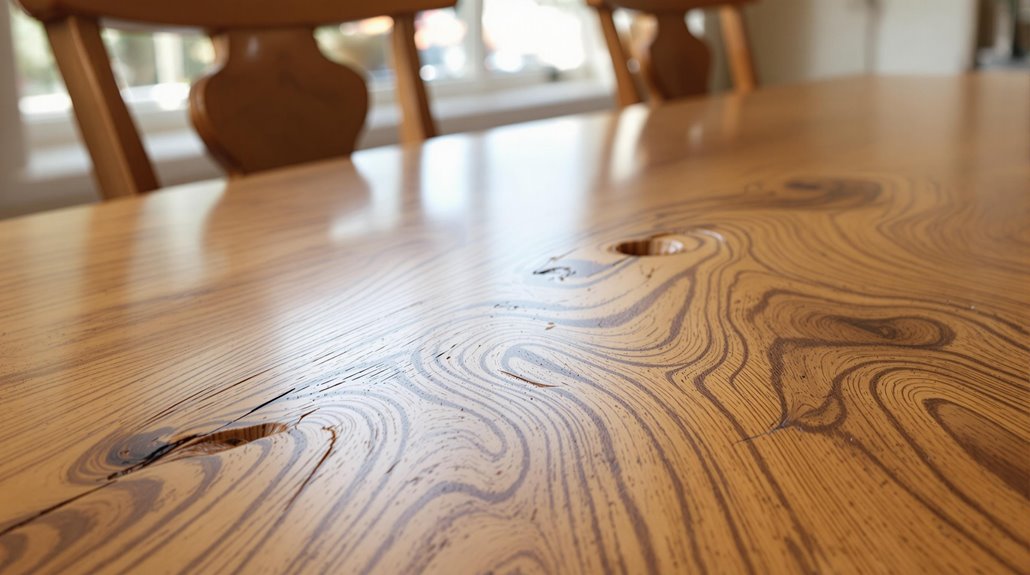Solid wood furniture is expensive due to high-quality raw materials, often sourced from slow-growing hardwoods like oak and walnut. These woods are not only durable but also more difficult to harvest sustainably, driving up costs. Additionally, the craftsmanship required for solid wood pieces involves skilled artisans employing labor-intensive techniques, which further increases production expenses. The unique aesthetic appeal of each piece, combined with its longevity and environmental benefits, adds value over time. Such furniture often reflects a commitment to sustainability and responsible sourcing, presenting a worthwhile investment for those prioritizing quality. Further insights on this topic await those interested.
High-Quality Raw Materials
The foundation of solid wood furniture's expensiveness lies considerably in the high-quality raw materials utilized in its construction. Hardwoods, such as oak, maple, cherry, and walnut, command higher prices due to their durability and slow growth rates. Tropical species like teak and mahogany are also costly, influenced by limited global supply. The rarity of certain woods, particularly walnut, further elevates costs. Additionally, sustainable harvesting practices, including FSC certifications, contribute to the overall price, as responsible sourcing often involves greater investment. The exceptional durability and aesthetic appeal of high-quality hardwoods guarantee longevity, reducing the need for replacements. This commitment to premium materials and meticulous craftsmanship is a significant factor in the expensiveness of solid wood furniture.
Unique Aesthetic Appeal
Solid wood furniture captivates with its unique aesthetic appeal, largely attributed to the inherent characteristics of the wood itself. Each piece showcases distinct grain patterns, which can range from subtle to bold, depending on the type of wood, such as oak, cherry, or walnut. These patterns not only enhance the visual appeal but also influence durability, as certain grain configurations may be more susceptible to splitting. Additionally, solid wood develops a natural patina over time, enriching its character and authenticity. Natural imperfections, like knots, contribute to its individuality, ensuring no two pieces are alike. This organic quality, combined with solid wood's timeless elegance, allows it to seamlessly complement various interior styles, making it a sought-after choice for discerning consumers.
Superior Craftsmanship
While the allure of solid wood furniture often lies in its aesthetic appeal, the superior craftsmanship behind each piece is equally significant. Skilled artisans employ traditional woodworking techniques, resulting in uniquely crafted items that showcase intricate details and a high level of mastery. The labor-intensive process involves time-consuming methods such as mortise and tenon joints, dovetailing, and precise finishing, all contributing to the furniture's quality. The extensive hours devoted to handcrafting each piece increase labor costs, reflecting the expertise required. Additionally, specialized techniques, including soft-close drawer glides and floating panels, enhance functionality and complexity. Such meticulous craftsmanship guarantees that each item not only meets high standards of quality but also exemplifies the dedication and skill of its creator. This attention to detail aligns with the principles of wholesale furniture advantages, ensuring retailers can offer unique, quality pieces that stand out in the market.
Durability and Longevity
As homeowners seek furniture that stands the test of time, solid wood options emerge as a premier choice due to their exceptional durability and longevity. Constructed from high-quality hardwoods like oak, walnut, and cherry, these pieces are naturally strong and resilient, capable of withstanding daily wear and tear. With proper care, solid wood furniture can last for decades or even centuries, often developing a beautiful patina that enhances its aesthetic value over time. Key factors influencing longevity include the type and quality of wood, stable humidity levels, and protection from direct sunlight. Regular maintenance, such as dusting and using protective pads, is essential for preserving the furniture's condition, ensuring it remains functional and visually appealing for years to come.
Sustainability and Environmental Factors
Recognizing the growing demand for environmentally responsible products, the sustainability of solid wood furniture has become a pivotal consideration for consumers. Wood is a renewable resource, often sourced from certified forests, ensuring a sustainable supply chain. Many manufacturers utilize reclaimed or recycled wood, considerably reducing waste and the need for new materials. Environmentally, wood furniture is carbon-neutral, absorbing CO2 during growth and avoiding harmful emissions during production. Unlike synthetic materials, which can take centuries to decompose, solid wood is biodegradable and has a smaller environmental footprint. Additionally, responsible sourcing practices and eco-friendly production methods minimize harmful chemical exposure. Ultimately, the commitment to sustainability in solid wood furniture contributes to its higher cost, reflecting the investment in environmental stewardship.

